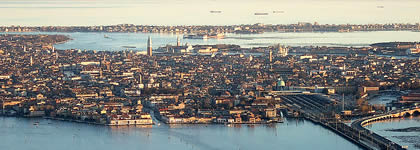The city of Venice with its famous canals traces its origins back to a small settlement in the Venetian lagoon where St. Mark, one of the authors of the Gospels and a friend of St. Paul, landed on his way to Rome.
With the collapse of the Roman Empire, and the sacking of Rome by Alaric and the Visigoths in 410, many people fled into remote parts of the countryside, and some found refuge in the islands in the lagoon. This led to the founding of Venice in 452. It and neighboring settlements grew, and by the sixth century there was a type of federation formed by which the communities elected a regional authority.
In 697 Paolo Zucio Anafesto was elected as the first doge, and he ruled the area under the nominal control of the Byzantine Empire. In 726 Venice founded its navy under Doge Oro Ipato, and in 787 this navy helped in the overthrow of the Lombards.
  |
In 810 at the peace of Aix-la-Chapelle, the Holy Roman Emperor Charlemagne ceded the control over Venice to Byzantium, and in the following year the seat of government in Venice was moved from Malamocco to the Rialto.
The main church in Venice, St. Mark’s Basilica, was originally built in 828 after the body of St. Mark was taken to Venice from Alexandria. It was said that an angel had foretold that the saint would be buried in the place he had landed when he was brought to Italy.
The doge who was responsible for the first basilica was Giustiniano Participazio, and the building was consecrated in 832. However this structure was destroyed by fire in 976, in an uprising against the doge.
 |
| Venice nowdays |
The rebuilt basilica was demolished in 1063 and Doge Domenico Contarini had a much larger one constructed. This was finally consecrated in 1094 and was officially the private chapel of the doge until 1807, when it became the city’s cathedral.
Venice grew as a naval power but in 839 was defeated by the Turks at the Battle of Taranto. In 932–939 they managed to conquer lands in Istria, and in 999–1000, the doge Pietro Orseolo II conquered Dalmatia (modern-day Croatia). In 1081 Byzantium was forced to cede sovereignty over Venice with the signing of a commercial and political treaty.
 |
| Evening in Venice |
The next threat to Venice came from the Normans, but the Venetians were able to defeat them at Butrint in modern-day Albania in 1085. By the 10th and 11th centuries Venice had emerged as an important trading port, prospering greatly during the First Crusade of 1095.
Further crusades and trade with the Holy Land led to massive wealth flowing to the merchants of Venice, who had gained exemption from tolls from the Byzantines. The city was rapidly emerging as a challenge to the authority of Constantinople. In 1124 the Venetians took the city of Tyre, a port in the Holy Land.
Doge Enrico Dandolo persuaded the crusaders of the Fourth Crusade to attack Constantinople, and they captured the city in April 1204. Many great treasures and pieces of art were brought back to Venice, including the four horses that have been displayed in St. Mark’s Square, with the exception of the period when Napoleon Bonaparte took them to Paris.
   |
Much of the Byzantine lands was occupied by Venice, which established an empire occupying the eastern coast of the Adriatic— modern-day Slovenia, Croatia, Montenegro, Albania, as well as parts of Greece. Venetian castles built during this period can still be seen on Corfu, along the coast of modern-day Croatia, at Durrës (Albania), and at Iraklion, Crete.
Venetian merchants also opened up trade with the Turks, and in 1271 Marco Polo set off from Venice to China, returning 20 years later. Venetian ambassadors were prominent at the court of many kings and rulers throughout Europe. In several cases their reports provide extensive accounts of life in those countries.
Although the doge of Venice was elected, ruling through the Consiglio dei Dieci (Council of Ten)— introduced as an emergency measure, and then made permanent in 1334—control of the city ended up with a handful of families who made up a formidable oligarchy.
This was confirmed by a decree in 1297 that limited membership of the Maggior Consiglio (Great Council) to those whose births and marriages were recorded in the Venetian Libro d’oro (Golden book), which was held at the Palazzo Ducale. The wealth of the city was measured in gold coins known as sequins, first minted in 1284 and quickly recognized as a mode of exchange throughout the Mediterranean.
During the 13th and 14th centuries Venice was involved in battles with Genoa for control of trade in the Mediterranean. The Venetians destroyed the Genoese fleet at the Battle of Chioggia in 1380, giving them supremacy for the next 100 years.
At this point the Venetians turned their attention to establishing a greater presence in the north of the Italian peninsula, taking Lombardy and Emilia-Romagna. In 1406 the Venetians captured Padua, and in 1441 controlled Ravenna.
It was the Ottoman Turks who finally led to the decline of Venice. In 1453 they captured Constantinople and closed off Venetian access to the east, in order to lead Portuguese sea expeditions around the coast of Africa, in search of spices previously obtained by the Venetians.
In 1470 the Venetians lost control of Negropont (Euboea) in Greece, to the Turks. In 1499 the Turks captured Morea in Greece from the Venetians, and this gave them control of the southern Adriatic. Although Venice started to decline as a maritime power, it remained a formidable political power during the Italian Renaissance.

